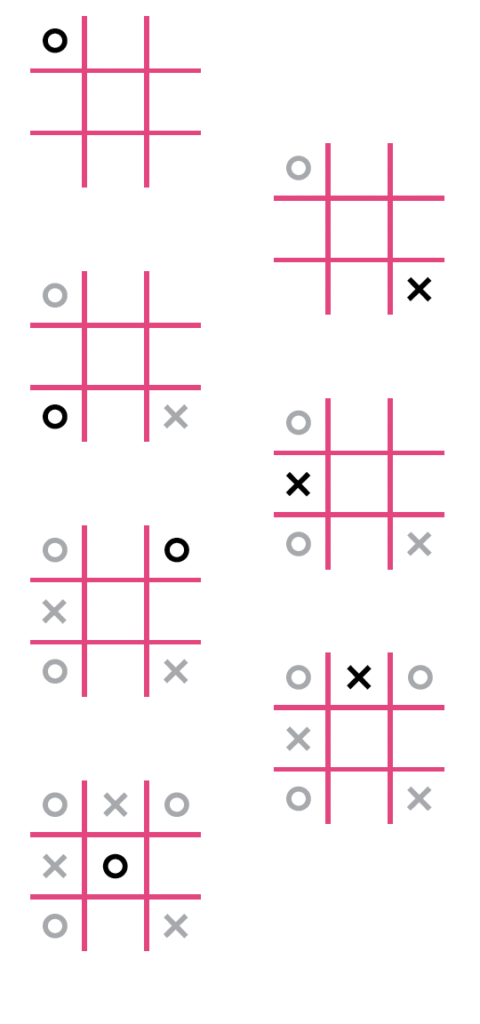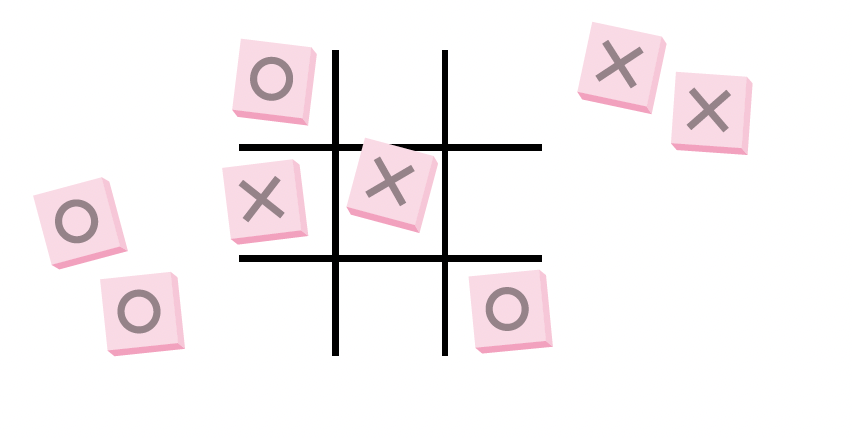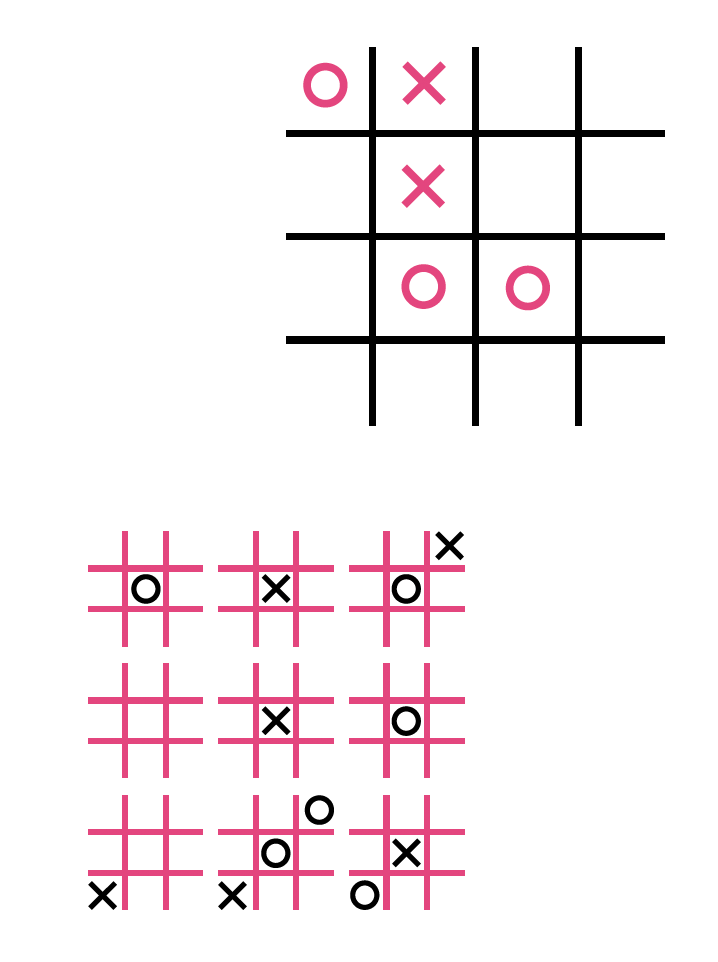Note from the Editors: Eric Zimmerman is an award-winning game designer, Arts Professor and founding faculty at the NYU Game Center, and a co-founder of the Institute of Play, a nonprofit that looks at the intersection of games and learning that designed public schools based on play as the model for learning.
In his newest book, The Rules We Break: Lessons in Play, Thinking and Design, he shares insights on his approach to board game design through essay and hands-on activities for the classroom. We’re proud to share an excerpt from his new book as part of Issue I of Board Game Academics
Diagrams created by Benjamin English
AGAINST THE RULES
Logical, rigid rules are the very opposite of unexpected, creative play. Yet we design play by designing the rules, out of which play emerges.
Rules are the raw material of game design. Open a board game: What’s inside? A deck of cards, a couple of dice, a game board, maybe some colorful pawns. Yet the rules of the game are what help you understand how to deploy these materials in play. Rules are the structural underbelly of games—the engine under the hood— that players enact to set a game in motion.
In most games, the rules need to be absolutely, completely clear to everyone—without exception. Imagine playing Baseball in a park and using a tree as second base. A player holding on to a branch of the tree is tagged out, and an argument begins. One team thought only the trunk was second base, but the other team thinks it’s the whole tree! Who is right? For the game to continue, this confusion needs to be resolved. Rules are funny this way. They insist on maximum clarity: rules are logical, fixed, and unambiguous. What does it mean when my token lands on a red square? I don’t know—let’s look it up in the rules. To play a game, you must follow the rules and submit to their authority. From this point of view, games don’t sound like much fun. Enter my dictatorship of rules and obey!
But that’s not the way it works. When you actually begin a game and decide to limit your behavior to the restrictions dictated by the rules, what happens is play. And play is the opposite of rules. While rules are fixed and rigid and logical, play is unpredictable and spontaneous and creative. This is a deep and profound paradox.
Play is everything rules are not—but at the same time, is dependent on and emerges out of rules.
This same relationship—a rigid structure that results in unexpected spontaneity—appears in all kinds of systems and situations. The designed structures of a building limit how people can move but cannot ever predict the romantic encounters or late-night parties that may happen inside. The rules of English grammar structure the possibilities of language but could not alone result in a poem by Emily Dickinson or the front page of the New York Times.
Designers create structures—like the rules of a game. Through an almost magical process, these structures wind up producing play. The trick is helping beautiful play bloom out of the raw materials of rules. This happens when you pay attention not just to the rules themselves but to the whole situation. Who is playing your game, and why? What are their expectations and states of mind as they begin? What might encourage your players to engage with and embrace the rules—just enough—so that they melt away into the jouissance of play?
DYNAMIC BEHAVIORS
Systems are everywhere. Thinking in terms of systems illuminates how parts become wholes and how we relate to the world and to each other. More important than the isolated parts of a system is how it behaves over time.
Snowball and catch-up effects are powerful tools for shaping what systems do.
Complicated systems are never just a static formation, like the legs of a stool holding up a seat. A complex system is more like a machine with intricate moving parts or an organism responding to constant input. The relationships between elements change dynamically over time.
Let’s say you’re playing a game of Chess. Your opponent makes a burst of strong moves, capturing some of your key pieces. A snowball effect starts to happen—the fact that your opponent has more pieces on the board means they can press their advantage, leading to yet more captures and even more dominance. Your opponent’s advantage accelerates, building on itself in an increasingly inevitable, vicious cycle feedback loop.
The same reinforcing cycle happens in realtime strategy games, when doing well early on helps you win even faster. And it happens in real-world economics, as the rich use personal wealth to avoid paying taxes and get even richer. An ability to gather and deploy resources lets you gather and deploy even more resources: a small advantage quickly becomes a huge power disparity. In the United States, politicians in power often get to redraw their own state voting districts. The result? The snowballing phenomenon of gerrymandering. Those in power can entrench their position, ensuring that they stay in power and entrench even more. These kinds of accelerating processes, also called positive or reinforcing feedback loops, aren’t always bad. A snowballing process can help push a game toward conclusion and keep it from stalling out in a grueling stalemate. In contrast, reinforcing loops in law and policy can too often reinforce inequality. (Indeed, democracy is a system too, with its own dynamic behaviors—a system very much in desperate need of redesign.)
Sometimes the opposite of a snowball occurs: catch-up mechanics. When you are behind in many racing games, your virtual car is given a “rubber-banding” boost so that it springs forward and doesn’t fall too far behind the lead car.
Why? Because closer matches, in which vehicles are jockeying tightly for position, are exciting! Unlike snowball effects that magnify differences, catchup mechanics assist those who are behind (or drag back those who are ahead), helping to keep everyone’s hope for victory alive and to maintain uncertainty until the end of the game. Similar catch-up dynamics, also known as negative or balancing feedback loops, regulate heating and cooling of buildings, or happen when an overzealous predator reduces its own food supply, or when customers complain and by doing so improve corporate policies and reduce complaints.
The classic Eight-Ball version of Pool (circa 1900) has both species of system behaviors built into the design—something I learned from game design educator Jesse Fuchs. When you sink one of your balls, there is a snowball feedback loop: you immediately get to take another shot, rewarding your success and compounding your progress toward victory. Yet there is simultaneously a catch-up mechanic at work too: the more balls you sink, the fewer targets there are on the table, and the harder it is for you to find a clear shot, which helps players who are behind. The dramatic pacing of Pool emerges through this interplay between snowball mechanics that add momentum and catch-up mechanics that level the playing field.
Snowball and catch-up loops are incredibly influential in sculpting the dynamic pace and balance of a system. Is your designed experience dragging on and lacking dramatic tension? Is it diminishing or exaggerating inequalities? Uncovering hidden feedback loops is a powerful tool for critiquing and redesigning relationships of power—both in and out of games.
Modding Tic-Tac-Toe
Take the classic game of Tic-Tac-Toe, change some rules, and see what happens. An introduction to modifying, designing, and communicating game systems.

What You Need
- Any number of players, working in pairs, in person or remotely online
- 45–60 minutes
- Writing and drawing supplies
- Prototyping materials (optional)
What You Learn
- Understanding rules and modifying them to change the experience of play
- The iterative design process of experimentation and playtesting
- Communicating a design by writing out its rules
1. Establish the rules of the game
Start by drawing a game of Tic-Tac-Toe on a whiteboard. Then ask what the rules of Tic-Tac-Toe are. What do we need to know in order to play? Brainstorm the rules together by having people shout out suggestions. You will likely end up with something like this:
- Play takes place on a 3 × 3 grid
- 2 players play together
- Players alternate placing an X or an O on an empty square
- 3-in-a-row of the same symbol is a win for that player
- If neither player can make a move, the game ends in a draw
Note that rules of good strategic play (play in the center first or block if your opponent is about to win) are different from the actual game rules. You can play the game badly and ignore good strategy but still play correctly by the rules.
Discuss: How do logical rules become a system of play?
Think of rules as a kind of language. Every game of Tic-Tac-Toe that has ever been played—whether on a classroom whiteboard or by drawing lines with sticks on a beach—has followed these rules. The rules form the grammar for speaking the language of Tic-Tac-Toe. It’s staggering to think about the billions of hours of behavior that the simple rules of Tic-Tac-Toe have generated.
Discuss: Is Tic-Tac-Toe fair?
Yes, it is fair in that the 2 players follow the same rules in the same way. At the same time, no, it’s not really fair because whoever goes first has a strong advantage. Or, perhaps, if every game ends in a draw, it actually doesn’t matter who goes first.
2. What can we change?
Have the group brainstorm a list of possible changes that could deepen, expand, or just mix up the game. That might include things like:
- size or shape of the grid
- winning conditions
- types of symbols you can draw
- where and how you can place a symbol
- permanence of symbols (maybe you can move them or erase them)
- number of players
- available time on your turn

Think about: Design intent
Beyond just changing the game for the sake of changing it, what is a larger goal that could help guide a redesign? For example, making Tic-Tac-Toe more exciting, or strategically deeper, or, conversely, more random and arbitrary. Perhaps it could be possible to make the game fairer by taking away first-mover advantage. Or the opposite: leaning into the game’s asymmetrical inequality and intentionally make it less fair.
Think about: Changing the story
Beyond the structural aspects of the game—the abstract, formal elements—are there other things that could be modified? For example, what about the content or narrative of Tic-Tac-Toe? What happens if the classic “noughts and crosses” are replaced with cats and dogs? Or cops and protestors? Are the 2 players given identities or roles of some kind? One way to spin this entire exercise is to focus on how a mod of Tic-Tac-Toe might embody or depict unfairness, inequality, or oppression.
3. Mod the game
Have designers work in pairs (a group of 3 is OK—they can try out a mod for 3 players). Because the groups will be paired up later on, arrange things so that you will have an even number of groups. They should try out their rule-change ideas by actually playing their own new versions of the game—as soon as possible. If you do have physical materials on hand movable tokens, 6-sided dice. stackable blocks, sticky notes—encourage players to use them! Physical affordances will suggest new play mechanics.
Think about: How to shut up and play
This is key. Help the designers fight the tendency to discuss and debate ideas in the abstract instead of trying them out and seeing how they work in practice. Encourage them to stop talking and start playing. Each group should grab the first idea that comes up and just play it out. Then quickly discuss what happened, make adjustments, and play again. This cyclical process is the essence of iterative design.
Think about: Modifying only a rule or two at a time
As they settle into an iterative process, it’s best to change something small and see what happens. If you change too much all at once, it’s difficult to determine which changes are affecting the play in what ways.
4. Write out new rules
Once everyone has a somewhat playable new version, pause their design processes. Have each pair of designers write out the rules of their new version of the game on paper. Tell them to make a complete set of rules, written for a player who knows nothing about how to play the game. Encourage them to be as explicit as possible, including diagrams and illustrations, if needed. This is a chance for them to practice the crucial design skill of communication.


5. Painful playtesting
Pair up the groups, so that each team is assigned to another team. The 2 paired groups will play each other’s games.
One of the groups in each pair watches silently while the other group tries to play the first group’s game by only reading and following the written rules. The designers are absolutely forbidden from trying to verbally explain their games to each other. Be very strict about this! See if the rules alone can explain the games. If players are confused, don’t help them—wait and see if they can muddle through, even if they get some details wrong. If players are completely stuck, designers can help explain, but the goal is to realize how difficult it is to communicate rules well.
When the playtest is done, it’s the other group’s turn. Now the former playtesters get to see their own game being played while they watch in painful silence. Everyone should have a chance to playtest someone else’s game and a chance to see their own game being played.
Discuss: As a player, share something you experienced
Rather than have each group share what they designed, ask participants to talk about the game they played. What was unexpected or engaging about the mod they experienced? Having people talk about designs made by others, rather than going methodically around the room as each group makes a “design presentation,” makes for a more spontaneous discussion.
Discuss: As a designer, whose game was understood perfectly?
Ask for a show of hands to see whose game was not played exactly according to the intended rules. Silently looking over someone’s shoulder as your design is being misunderstood is very difficult! But it’s absolutely essential practice in the meditation-under-the-waterfall discipline of nonintrusive playtesting.
Discuss: Were there any misunderstandings that led to new ideas?
Accidents and confusion can be creatively productive. It may be that some of the playtesters stumbled upon interesting new ways to play. Did this happen to anyone?
Context
Anyone can modify Tic-Tac-Toe and immediately experience how small changes in rules can produce unexpected results there are so many ways to mod even this simple game. In a short amount of time, this exercise can encapsulate the entire design process: analyzing a system, prototyping and trying out changes, communicating to players, and even observational playtesting. For more Tic-Tac-Toe modding inspiration, see chapter 5 of The Well-Played Game (1978) by Bernie DeKoven, where he offers a glorious avalanche of ways to change the game. Long live Tic-Tac-Toe!


Eric Zimmerman
Game designer & Arts Professor
NYU Game Center
Eric’s professional life is about inventing new ways for people to play and teaching others about the craft and relevance of games. He has worked in the game industry for more than 30 years, designing award-winning digital games, tabletop games, and large-scale installations and writing books that helped establish the discipline of game design.
